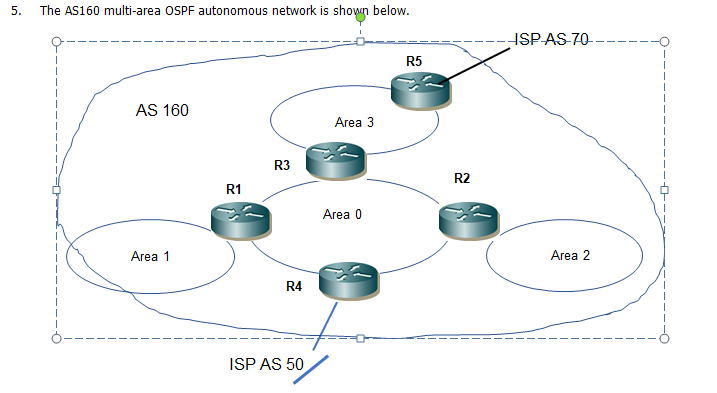Question
Assume that the following number of routes (aka prefixes) exist in each of the networks: Area 0: 50 routes Area 1: 50 routes => stub

Assume that the following number of routes (aka prefixes) exist in each of the networks:
Area 0: 50 routes
Area 1: 50 routes => stub area
Area 2: 50 routes => totally stubby area
Area 3: 50 routes => not so stubby area (NSSA)
AS 70: 100 routes
AS 50: 100 routes
(12%) Complete the entries in the table below:
| Type of routes | Area 0 Routers | Area 1 Routers | Area 2 Routers | Area 3 Routers |
| # of O intra routes |
|
|
|
|
| # of IA routes |
|
|
|
|
| # of external routes |
|
|
|
|
| # of default routes |
|
|
|
|
| # of N2 routes |
|
|
|
|
| Total number of routes |
|
|
|
|
(5%) Identify the router types (e.g. ABR, ASBR)
| Router | Router Type |
| R1 |
|
| R2 |
|
| R3 |
|
| R4 |
|
| R5 |
|
(4%) Assume that you strive to minimize the number of router entries in your routers (as you always do!). What one change can you do (a configuration change of one of the areas) to reduce the number of router entries?
5. The AS160 multi-area OSPF autonomous network is shown below. SPAS-70- R5 AS 160 Area 3 R3 R2 ?1 Area 0 Area 1 Area 2 R4 ISP AS 50 5. The AS160 multi-area OSPF autonomous network is shown below. SPAS-70- R5 AS 160 Area 3 R3 R2 ?1 Area 0 Area 1 Area 2 R4 ISP AS 50Step by Step Solution
There are 3 Steps involved in it
Step: 1

Get Instant Access to Expert-Tailored Solutions
See step-by-step solutions with expert insights and AI powered tools for academic success
Step: 2

Step: 3

Ace Your Homework with AI
Get the answers you need in no time with our AI-driven, step-by-step assistance
Get Started


